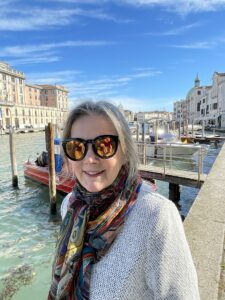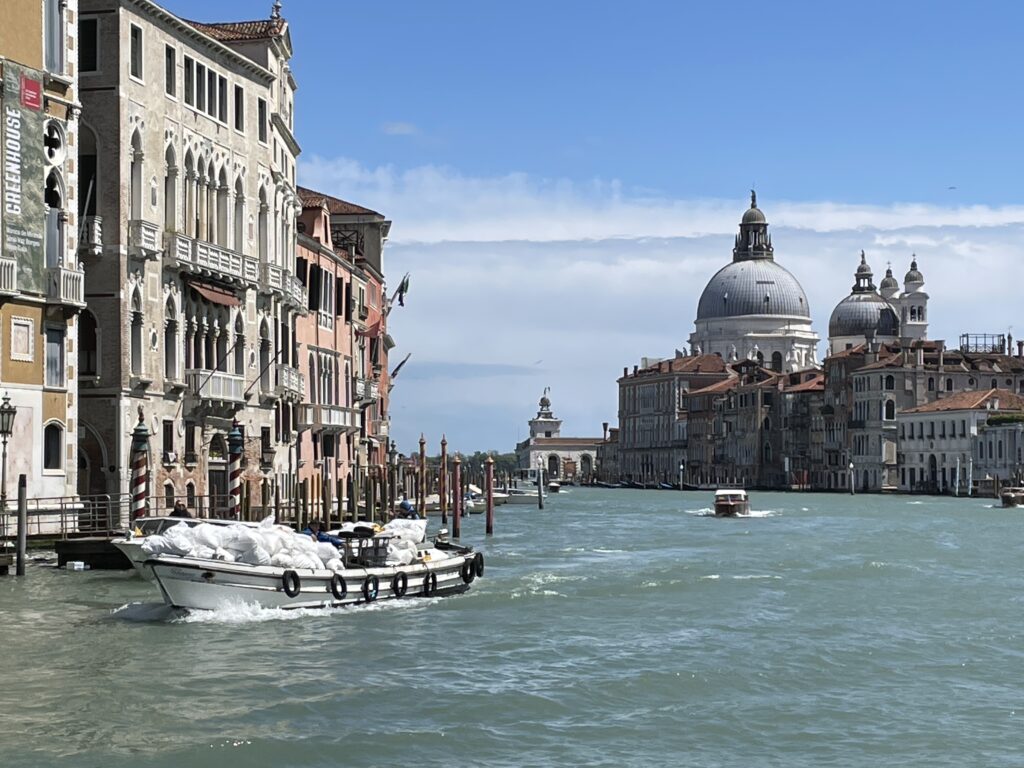
Having just returned from four days in Venice, I’m in that limbo phase, a reverse homesickness, in which I’m longing to be there again while trying to coax back to reality the part of me that didn’t quite make the flight home. The only way to deal with it is to write about it, so I’m going to tell you about Venice, specifically, how to make the most of four days there.
When people tell me that they have always wanted to visit Venice but ended up demurring because someone told them it was smelly, ugly and crowded, well, it makes me sad. Heat affects air quality in confined spaces; by how much depends on the time of year. Venice in April is fresh and fragrant; it’s said that early May, late September, and October, are also good. But let’s be honest: we have the planet we deserve. If Venice smells, that’s on us, not Venice.
My first visit was in 2006 with my mother who had mobility issues. So, be warned: Venice is not easy on the frail and unsteady. It demands stamina, agility, and fitness. You’re on your feet all day: hopping on and off boats; climbing up and over bridges; threading narrow, often crowded, laneways; hiking through vast museums and galleries, and squeezing between café and restaurant tables. There are no motorised vehicles—or golf carts, as I heard one woman ask—and uneven cobbles judder walking frames the same as they do to wheeled luggage.
While I’m all for being guided by kismet, it helps to book a few things in advance, especially if your stay is brief. You’ll want to book a museum pass (visitmuve.it) and maybe a restaurant or two. The museum pass (at the time of writing, €22 pp) gives you entry to 12 museums. Over four days, it’s a struggle to see six. Best of all, it’s scanned when you’re inside the building, which means you never have to line up.
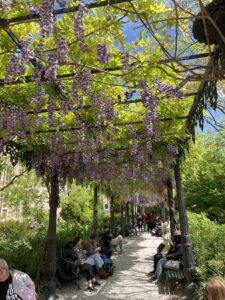
Day 1
There are many ways into Venice from Marco Polo Airport. A cab takes 20 minutes, but there’s also the water taxi. Although the trip takes an hour and a half, it’s said that approaching Venice by boat in the evening, the city lit up before you, is rather magical.
I’ve stayed in two places in Venice (both reasonably priced) and I’d stay in each again. The first is Locanda San Barnaba, housed in a 16th-century palazzo, and a two-minute walk from the Ca’ Rezzonico vaporetto stop. The second is Hotel Papadopoli, modern with a boutique feel, and an excellent location. When your taxi drops you at the car park near the bus station, you literally walk over a bridge, and the hotel is there. No hauling bags down narrow, unfamiliar lanes. If you travel heavy, you’ll appreciate this. Also, there’s a lovely park behind the hotel.
The first day is a get-your-bearings day. Wander around. Take it all in. If you’ve arrived early in the day, park your bags at reception, and get a map. Google Maps don’t work particularly well in Venice. You get around the old-school way. Buy a vaporetto ticket from a news kiosk or vaporetto station, and hop on the #2, which travels the entire Grand Canal. At Piazza San Marco, head to the Campanile. A lift takes you to the top for 360-degree views of the city.
By 2pm, you’re hungry. Around the corner from La Fenice, the famed opera house, is an oasis, a place to enjoy a drink and share a pizza in the restaurant’s courtyard.
When it comes to dinner, first nights are always a crap shoot, especially on a Saturday. Places fill up early. Luckily, there is plenty of choice around you.
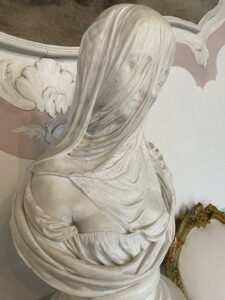
Day 2
Some hotels offer a free water taxi to the island of Murano to see the glass works. If not, take the vaporetto. Glass blowing is a magical art, and there are lots of places to see it on Murano. However, if you’ve opted for the “free” trip/tour, you’ll find it’s less about showing and more about selling. You are herded swiftly away from the glassblower’s forge and into a smart gallery of sparkling sculptures, chandeliers, vases, dinnerware, and jewellery. A small item that caught my eye was €800, and that included the 30% discount we were offered. A vase was priced at €11,000. I left with a beautiful pair of earrings for €60.
The “free trip” is keen to get you back on the water taxi and whisk you back to Venice before you’re tempted to check out the competition. It’s up to you: take the “free trip” there, then slip away and explore Murano, maybe stop for a coffee or lunch, and take the vaporetto back. Otherwise, return on the water taxi where it will likely drop you at the Rialto Bridge (a zoo), and make your way to Ca’ Rezzonico.
Ca’ Rezzonico might become your favourite gallery. It’s surely mine. If you visit only one in Venice, choose this. It combines the grandeur of a 17th-century palazzo with three or four floors of extraordinary art. Tiepolo, Tintoretto, Guarana, Molinari, Zuccarelli, Guardi, Corradini, they’re all here. Even the gilded frames are works of art.
Dinner that night might be that place you booked ahead of your visit. Perhaps you went online to look up a restaurant featured in one of Stanley Tucci’s travelogues only to discover lukewarm reviews. If you come across Oficina Ormesini (oficinaormesini.com), make a booking. Helpful, knowledgeable wait staff. Quiet, casually refined vibe. Absolutely terrific food.

Day 3
You can’t rely on the weather. Wind and rain practically blew us into the canal as we boarded the #4.1 for the island of Giudecca. The Biennale 2024 was underway, and I had booked tickets several days before our arrival for the Vatican’s chosen exhibit space—a women’s prison. It was challenging on many levels: a security check, belongings confiscated: No phones. No photos. A cold whipped through the external corridors where we listened to three prisoners describe life on the inside and gave us a tour. The Biennale runs every two years, and future exhibits are unlikely to be held here again, but this is the sort of off-piste excursion that gives your visit a twist. A bit of pre-travel research goes a long way.
Back in Piazza San Marco, head to the Doge’s Palace. If you’re lucky, a remarkable exhibit on Marco Polo will still be running. Otherwise, you can wander through the enormous, opulent, frescoed rooms that lure thousands each year.
If it’s still rainy by evening, the easy choice is dinner at the hotel or somewhere within a 30-second walk. Resist such thinking. Brave the elements. As you scurry through Cannaregio, wind wrestling the umbrella from your icy hands, rain pelting everything in sight, the sirens sound, warning water craft to dock immediately. But once you blow into Orient Experience (orientexperience.it), wet and disoriented, you know it was worth it. Founded and run by refugees, it’s both restaurant and social enterprise, training migrants for work in the hospitality business. The food is hearty and delicious, and reflects the dishes of other cultures that refugees have encountered on their way from the Middle East to Venice.

Day 4
Take an early vaporetto to Piazza San Marco, and have a coffee at The Florian. It’s a 300-year-old institution, permanently packed, with a line-up to get in. By 9:30am, it’s already filling up. But what a treat: The mirrored and gilt interior has barely changed since 1720; efficient waiters in crisp white jackets bring your order on a large silver tray. This isn’t Tim’s. Two cappuccinos and an order of two toasted scones with jam and cream will set you back €45. In nicer weather, a string quartet plays and you can linger over your coffee at a table on the piazza.
Across the piazza from The Florian, flash your pass at the entrance of the Museo Correr, and tour its large display of ancient busts, coins, pottery shards, and art. It has a small exhibit dedicated to Marco Polo, not as comprehensive as the one at the Doge’s Palace, but with a slightly better display of ancient books and maps.
Afterwards, you might want to scour the labyrinth of lanes looking for Piazza San Maurizio where an antique market is held. (Just my luck: it had ended the day before.) It’s only held for three days a few times a year, so if a Venetian antique and curios market is your thing (and whose thing wouldn’t it be!) check the dates before you book your trip.
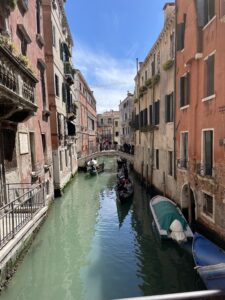
To be lost in Venice is a wonder. Every bridge, every side canal, every piazza induces sigh after sigh. Even in the rain it’s gorgeous. You’ll want a gondola ride—who can resist? It’s like Cairo without the pyramids, or London without Big Ben—but if the weather isn’t ideal, save it for next time.
Hop on the #2 and disembark at San Stae to visit Palazzo Mocenigo. It is billed as a textile and costume museum but it’s not quite that. Still, it’s a grand building with interesting exhibits. (Plus, you want to get your money’s worth on that museum pass.)
Walking back to your hotel through Cannaregio, you’ll wonder where to eat for your final night. You might stumble upon Ostaria al Vecio Pozzo (veciopozzo.it), and lay mental bread crumbs in order to find your way back later on. It turns out to be less than five minutes from Hotel Papadopoli.
Ostaria al Vecio Pozzo has none of the glamour and character you seek in a Venetian restaurant, but the staff are friendly and the food is great. Venice is a pescatarian paradise, but if you choose the grilled fillet steak it might be the best steak you’ve ever had. When the waitress arrives with your tiramisu (invented in nearby Treviso), ask her, “Did you make that?” Chances are she’ll reply: “Yes, I did!” Delicious.
Day 5
Pangs of resistance begin. You won’t want to leave Venice. If there’s time before the journey to the airport, there’s time for one last museum. The Natural History Museum opens at 9am, and it will make you wish you had a small child to enjoy it with you. Still, you’re alert to the time—not wanting to leave but knowing you must.
Before you know it, you’re in line to check in for your flight. A sign on the wall tells you that Marco Polo Airport has a silence policy: no loud-speaker announcements.
Yup. You’ll be back.
